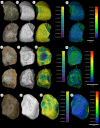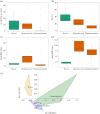Identifying functional and regional differences in chimpanzee stone tool technology
- PMID: 36147934
- PMCID: PMC9490349
- DOI: 10.1098/rsos.220826
Identifying functional and regional differences in chimpanzee stone tool technology
Abstract
The earliest hominin archaeological sites preserve a record of stone tools used for cutting and pounding. Traditionally, sharp-edged flakes were seen as the primary means by which our earliest ancestors interacted with the world. The importance of pounding tools is increasingly apparent. In some cases, they have been compared with stone hammers and anvils used by chimpanzees for nut-cracking. However, there has been little focus on providing a robust descriptive and quantitative characterization of chimpanzee stone tools, allowing for meaningful comparisons between chimpanzee groups and with archaeological artefacts. Here we apply a primate archaeological approach to characterize the range of chimpanzee nut-cracking stone tools from Djouroutou in the Taï National Park. By combining a techno-typological analysis, and two- and three-dimensional measures of damage, we identify clear differences in the location and extent of damage between nut-cracking hammerstones and anvils used at Djouroutou and when compared with other wild chimpanzee populations. Furthermore, we discuss these results in relation to interpretations of Plio-Pleistocene percussive technology. We highlight potential difficulties in identifying the underlying function of percussive artefacts based on morphological or techno-typological attributes alone. The material record from Djouroutou represents an important new datum of chimpanzee regional and material culture.
Keywords: Palaeolithic; archaeology; nut-cracking; percussive technology; primate archaeology; stone tools.
© 2022 The Authors.
Conflict of interest statement
We declare that we have no competing interests.
Figures






Similar articles
-
Searching for the earliest archaeological record: insights from chimpanzee material landscapes.J R Soc Interface. 2024 Aug;21(217):20240101. doi: 10.1098/rsif.2024.0101. Epub 2024 Aug 21. J R Soc Interface. 2024. PMID: 39163030 Free PMC article.
-
The archaeological visibility of chimpanzee (Pan troglodytes) nut-cracking.J Hum Evol. 2024 Oct;195:103582. doi: 10.1016/j.jhevol.2024.103582. Epub 2024 Aug 29. J Hum Evol. 2024. PMID: 39213793
-
Analysis of wild macaque stone tools used to crack oil palm nuts.R Soc Open Sci. 2018 Mar 21;5(3):171904. doi: 10.1098/rsos.171904. eCollection 2018 Mar. R Soc Open Sci. 2018. PMID: 29657792 Free PMC article.
-
Linking primatology and archaeology: The transversality of stone percussive behaviors.J Hum Evol. 2023 Aug;181:103398. doi: 10.1016/j.jhevol.2023.103398. Epub 2023 Jun 15. J Hum Evol. 2023. PMID: 37329870 Review.
-
Functional mastery of percussive technology in nut-cracking and stone-flaking actions: experimental comparison and implications for the evolution of the human brain.Philos Trans R Soc Lond B Biol Sci. 2012 Jan 12;367(1585):59-74. doi: 10.1098/rstb.2011.0147. Philos Trans R Soc Lond B Biol Sci. 2012. PMID: 22106427 Free PMC article. Review.
Cited by
-
Emergent technological variation in archaeological landscapes: a primate perspective.J R Soc Interface. 2023 Jun;20(203):20230118. doi: 10.1098/rsif.2023.0118. Epub 2023 Jun 21. J R Soc Interface. 2023. PMID: 37340784 Free PMC article.
-
Old age variably impacts chimpanzee engagement and efficiency in stone tool use.Elife. 2025 Jul 15;14:RP105411. doi: 10.7554/eLife.105411. Elife. 2025. PMID: 40660788 Free PMC article.
-
Searching for the earliest archaeological record: insights from chimpanzee material landscapes.J R Soc Interface. 2024 Aug;21(217):20240101. doi: 10.1098/rsif.2024.0101. Epub 2024 Aug 21. J R Soc Interface. 2024. PMID: 39163030 Free PMC article.
-
The mind & muscles: Introducing a validated EEG/EMG protocol for recording cognitive-muscular interactions in experimental archaeology.PLoS One. 2025 May 23;20(5):e0324103. doi: 10.1371/journal.pone.0324103. eCollection 2025. PLoS One. 2025. PMID: 40408369 Free PMC article.
References
-
- Leakey MD. 1971. Olduvai Gorge: volume 3, excavations in Beds I and II, 1960–1963. Cambridge, UK: Cambridge University Press.
-
- Isaac GL. 1986. Foundation stones: early artefacts as indicators of activities and abilities. In Stone Age Prehistory (eds Bailey GN, Callow P), pp. 221-241. Cambridge, UK: Cambridge University Press.
-
- Lemorini C, Bishop LC, Plummer TW, Braun DR, Ditchfield PW, Oliver JS. 2019. Old stones’ song—second verse: use-wear analysis of rhyolite and fenetized andesite artifacts from the Oldowan lithic industry of Kanjera South, Kenya. Archaeol. Anthropol. Sci. 11, 4729-4754. (10.1007/s12520-019-00800-z) - DOI
Associated data
LinkOut - more resources
Full Text Sources

